.
Post Impressionism
Georges
Seurat
(1859-1891)
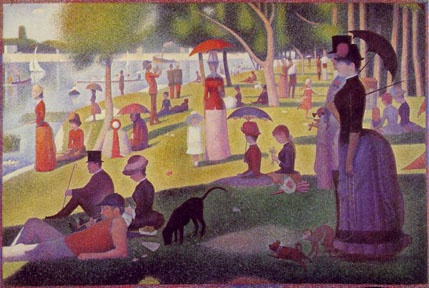
Sunday Afternoon on the Island
of Grande Jatte, 1884-85
Post Impressionism is a term
which is less easy to define than Impressionism. Though the impressionists
differed in personal styles and favorite subjects, one thing which was consistent
between the artists was their interest in the transitory effects of light
and spontaneous compositions. Though the post-impressionists are also concerned
with light, it is not as much of a central concern, and their personal styles
differ greatly.
When we look at the works of
Georges Seurat, for example, it is obvious that he is concerned with the
effects of light, but his compositions definitely do not evoke a sense of
the spontaneous moment. First and foremost, he is noted for his invention
of a method of applying paint in small dots of color. He called this method
divisionism, but the term pointillism is more commonly used today.
Seurat developed this method in response to his understanding of scientific
theories about the perception of light and color. It had recently been discovered
that light can be measured in particles as well as wavelengths. It had further
been concluded that when we see the various colors of the light spectrum,
our eyes perceive the various particles, but the mind mixes them into distincly
different colors. Seurat's paintings are a visual experiment of this idea,
placing tiny dots of various colors side by side, and allowing the viewer's
mind "mix" them. When perceived up close, they are a dizzying
array of vibrant colors. When seen from a distance, the image comes together
in a more muted palette, for the colors which are placed side by side become
mixed.
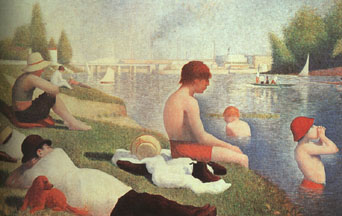
Bathing at Ausnieres,
1883
|
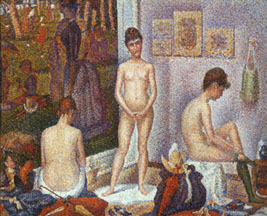
Models in the Studio,
1887
|
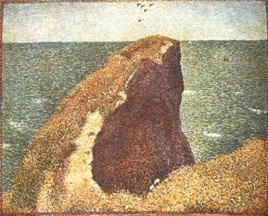
Le Bec du Hoc, Grandcamp,
1885
|
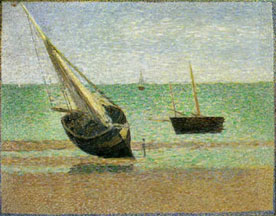
Boats, Low Tide 1885
|
Paul Cezanne
(1839-1906)
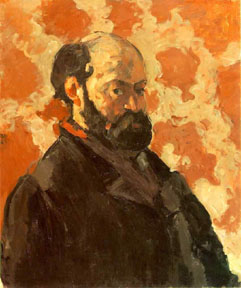
Self Portrait with Rose
Background, 1875
|
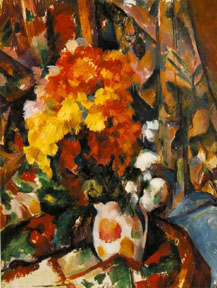
Chrysanthemums, 1896-98
|
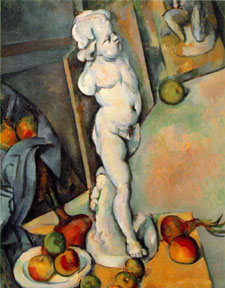
Still Life with Plaster
Cupid, 1895
|
Paul Cezanne was much less
scientific in his approach to painting than was Seurat. His paint seems
to be layed down in patches of color, dividing his canvases into many
various planes. His colors are bright, and there is frequently a confusing
sense of perspective. There is usually a very limited sense of depth
and the contents of his still-lifes seem to almost topple out of balance.
All of this is more purposeful than one might normally conclude, for
it adds a sense of tension to the artwork, which prevents the "still"
life from being quite as static.
Cezanne's decision to defy
the laws of perspective (and gravity) will greatly influence Picasso
and Braque's invention of cubism (look especially at his landscapes,
below, to see this relationship). With Cezanne, it becomes clear
that art is not merely a matter of copying what one sees. The modern
artist's mission becomes the purpose of re-creating the world to fit
the needs of art. |
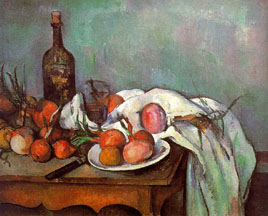
Still Life with Onions
|
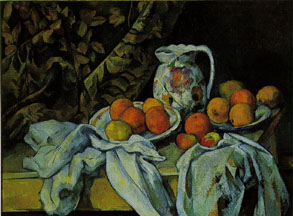
Still Life with Fruit
|
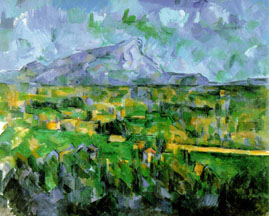
Mount St. Victoire,
1885-7
|
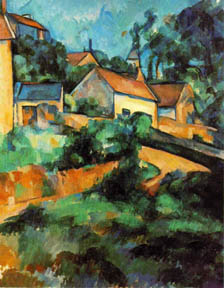
The Turning Road 1899
|
Vincent
Van Gogh
(1853-1890)
What we know of Vincent Van Gogh's tragic life is difficult to forget when
we view his artwork. In his self-portraits, it is easy to see the sensitive,
moody artist who was tortured by mental illness and personal tragedies. It
is possible to appreciate his paintings without knowledge of his personal
circumstances - but the more one learns of the man, the easier it is to fall
into the entrancing spell of his personal vision. His paintings are disturbing
and beautiful at the same time. I almost wonder if they would be beautiful
without an element of his troubled soul showing through them. He was a man
who had compassion for the world... who wished more than anything to be of
some useful purpose to others. His love of humanity and for nature show clearly
in his art as well as his letters. But his was a genius that might not have
blossomed had it not been for his failures.
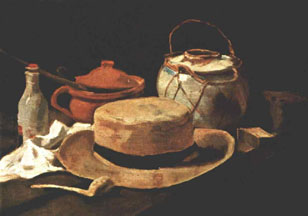
Still Life with Hat
and Pipe, 1885
|
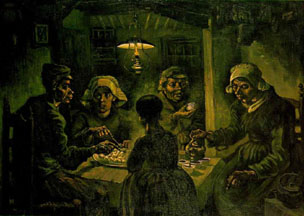
The Potato Eaters, 1885
|
Vincent first tried to be an art dealer, working in his uncle's gallery.
He was fired from the position because his opinions about the superficiality
of much of the art interfered with his ability to sell it, and his rough
manner was offensive to some of the customers. He then went to school to
train as a minister, another occupation which ran in his family. He was
given a post in a coal-mining town, a job which no other minister wanted
because of the desperate situation of the workers. He gave away much of
his clothing and food to the workers and lived in the same dirty conditions,
often helping them in the mines. A surprise visit by his church superiors
resulted in firing him from the position. The Potato Eaters is a
painting about the coal miners, which he created years later. Though crude
in comparison to his later works, it is successful in getting across his
message about the humble condition of these people, who lived close to the
earth. In an early still
life, we are reminded of Vincent's Dutch heritage. The dark, chiarascuro
manner of painting is influenced by hundreds of years in the shadow of Rembrandt.
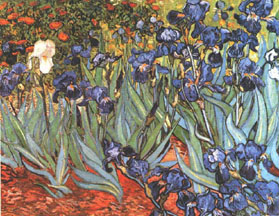
Irises, 1889
|
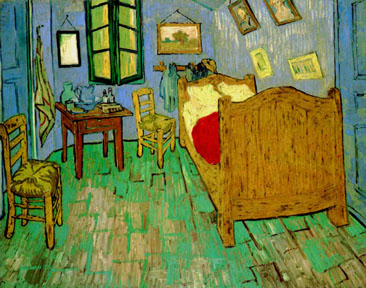
Bedroom at Arles, 1888
|
It is when Vincent
moves to Paris that he sees the works of the Impressionists which is to have
a profound effect on his use of color. Immediately, his work became bright
and full of light. His brother, Theo, was an art gallery dealer and was able
to introduce his older brother to many painters. Though he does make some
friendships (including those with Degas and Seurat) he doesn't quite fit in
with the Paris scene, and Vincent eventually moves to the town of Arles to
set up his own studio. He invites a fellow artist, Gauguin, to move in with
him. Together, they paint, drink in taverns, fight, and eventually the friendship
is terminated when Van Gogh, in one of his fits of emotional instability,
threatens his friend with a knife. When Gauguin gives him an angry look, Vincent
meekly turns away, then later slashes his own ear. He recuperates, but realizing
he is a threat to himself (and possibly others), admits himself to a mental
hospital.
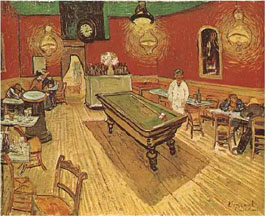
The Night Cafe, 1888
|
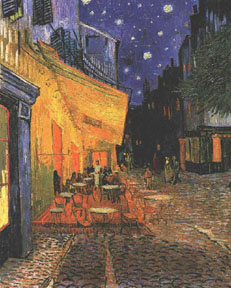
Cafe on the Place du
Forum, 1888
|
Despite Vincent's
emotional and physical instability, he managed to create some of his greatest
paintings in the last couple years of his life (having decided upon being
an artist only 8 years earlier). Unlike the Impressionists, he chose his colors
almost arbitrarily, painting not what he sees but what he feels. Vincent wrote
to Theo about Night Cafe, explaining that he chose red for the walls
to emphasize the idea that this is a place where a person can go mad.
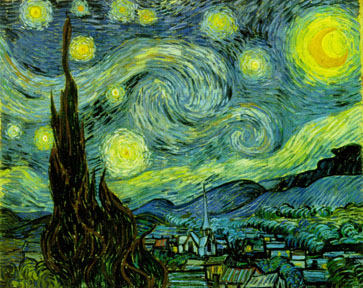
The Starry Night, 1889
|
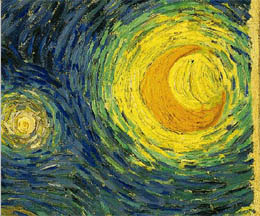
Detail of Brushwork, Starry
Night
|
The Starry Night is Van Gogh's
most famous painting, and perhaps his greatest. He paints the night sky
from a hilltop overlooking a quiet town with a church and cottages. The
most dramatic theme is the swirling stars, which dominate the scene. Competing
for attention is a towering group of Cypress trees. It is probably significant
that the Cypress is the traditional tree of graveyards, as they are a symbol
for eternity. Van Gogh seems to say with this painting that the works of
God and nature are everlasting and that the world of man exists merely as
a shadow.
Vincent grew increasingly depressed
as he realized that his mental illness would never be cured, couple with
the realization that he had become a financial burden to his brother, who
had recently fathered a child. It was in a wheat field that he shot himself.
He managed to crawl back to his home and news was sent to Theo of his tragic
condition. Theo came to say goodbye to his brother within hours of his death.
Six months later, Theo also died.
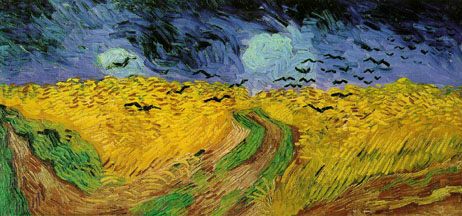
Wheatfield and Crows, 1890
Wheatfield and
Crows was one of the last paintings that Vincent had finished. Van Gogh's
name was still unknown at the time of his death. His first one-man show was
exhibited two years later. His fame was made largely by other painters, dating
the early years of the 20th century. He was a great influence especially to
the Expressionists, to Matisse and Picasso. Though he sold only one painting
in his lifetime, his works now sell for millions of dollars.
Paul Gauguin
(1848-1903)
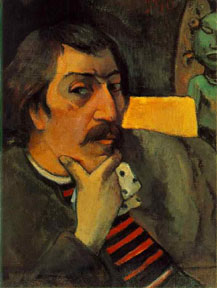
Self Portrait with Idol,
1893
|
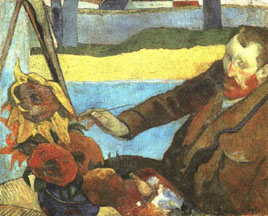
Van Gogh Painting Sunflowers,
1897
|
Gauguin, like Van
Gogh, decided upon a career in art rather late in life. He was a Parisian
stockbroker, who enjoyed painting as a weekend hobby. He exhibited with the
impressionists in the 1870s, and in 1883 gave up his job to pursue painting
full-time (this decision left his wife and 5 children with little money, so
his wife left him to live with her mother). He soon became a leader of the
Post Impressionist group in Paris. He then traveled to Pont Aven, a small
community in Brittany where he chose to study peasant life. Gauguin believed
that the people in this deeply religious region of France were closer to nature
and more sincere than those in the city of Paris. He was also attracted to
the expressiveness of the peasant costumes. In Vision After the Sermon, Gauguin
makes a bold statement about the religious faith of the Brittany community.
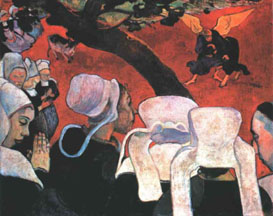
Vision After the Sermon,
1888
|
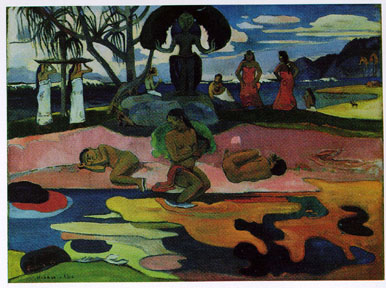
Mahana No Atua, 1894
|
The concept of spiritual purity continues to intrigue Gauguin, leading him
to travel to Tahiti. Here, he hopes to discover the "noble savage",
the ideal of a pure race of people who live close to the earth and are untainted
by European materialism. He finds that he has been preceded by missionaries
who have converted many from their native religion. There are other European
influences as well: alcohol, prostitution and venerial diseases. Instead of
focusing on these aspects of his new world, he decides to paint the natives
in a paradisal climate, enjoying the traditions of their native culture and
bathed in a hyper-colored atmosphere.
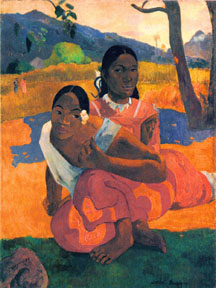
When Will You Marry?
1892
|
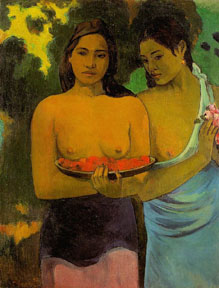
Two Tahitians
with Mango Blossoms 1899
|
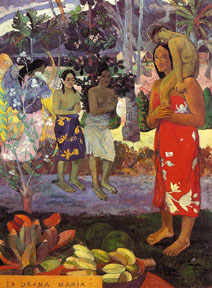
La Orana Maria 1891
|
Gauguin has by this time totally
given up any reference to the impressionistic brushstroke. Instead, he prefers
to lay down his saturated colors in a rather flat manner, filling the canvas
with bold and bright shapes. The canvas is also loosely woven, and its texture
can be seen through the paint. This technique seems to echo the subject
of the Tahitians, which he presents as enlightened primatives. He especially
painted the women, whom he felt possessed a quiet dignity and an innate
knowledge of life's mysteries.
Gauguin wrote about his feelings
for Tahiti as well as painting it, and in both he emphasized the mystical
and religious qualities of Tahitian life. He regarded the painting below
as his greatest masterpiece. He is, however, gravely ill at this time, and
attempts suicide as soon as he finishes it. He died a couple years later
after struggling with several illnesses.
|